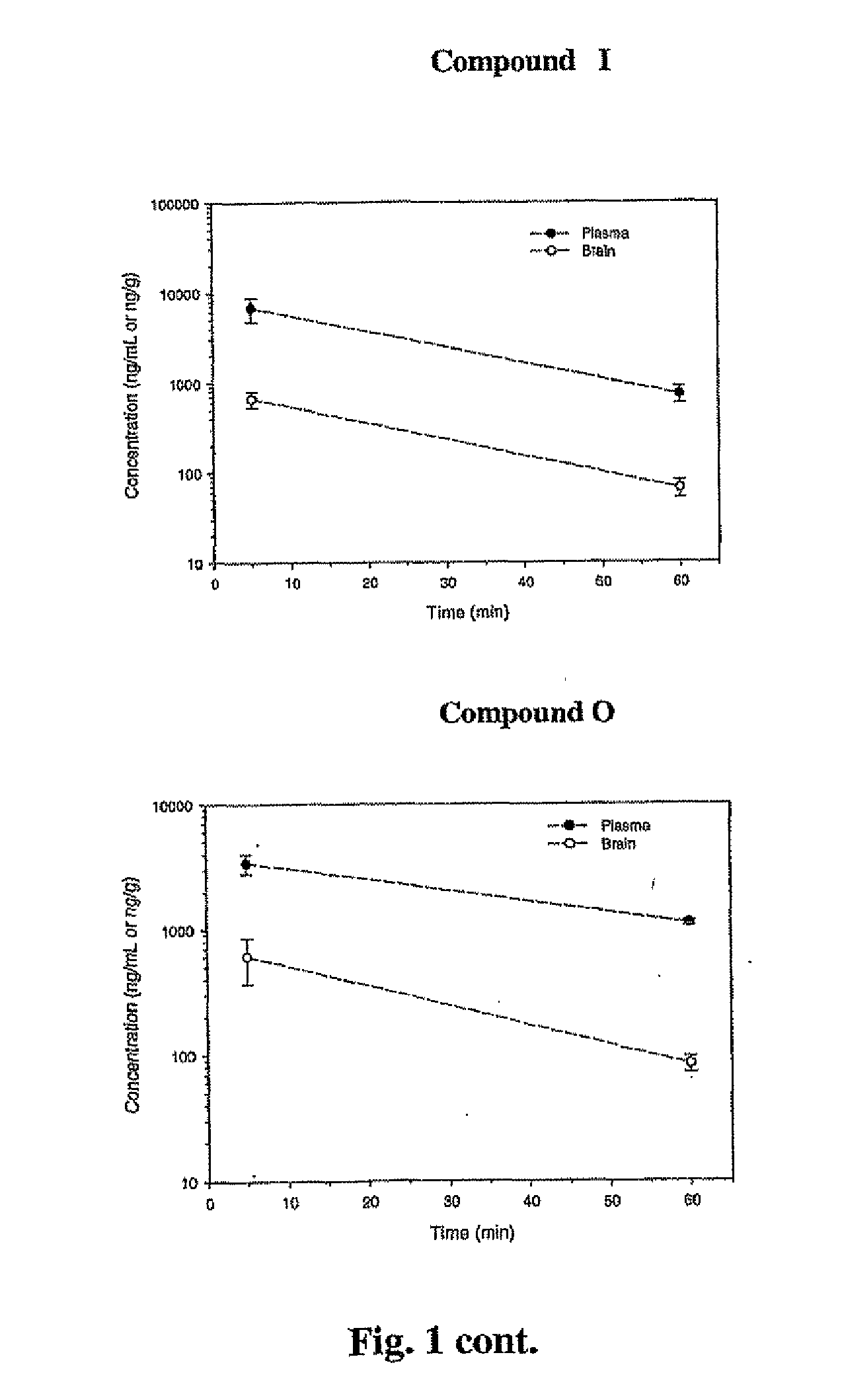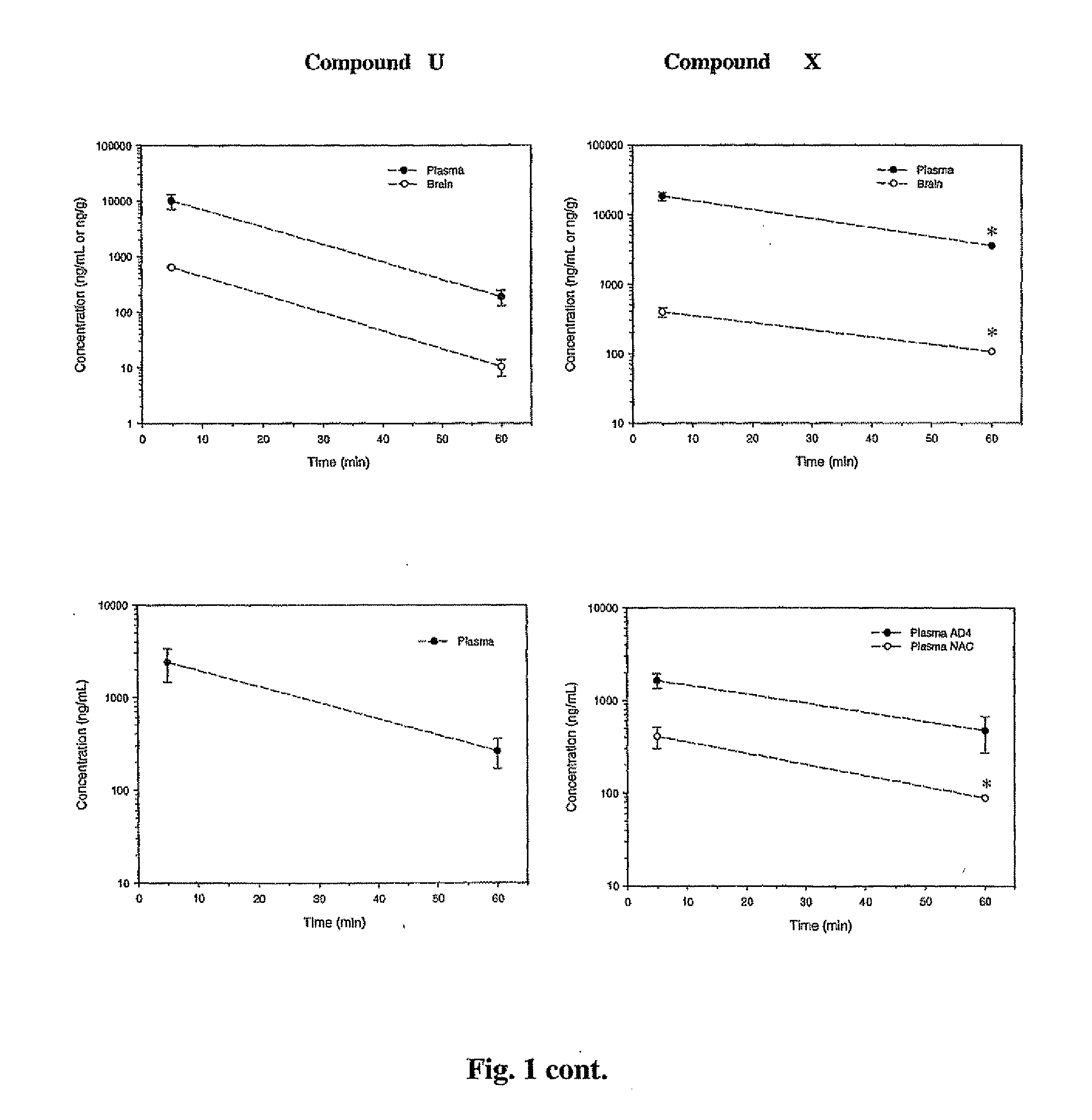Method of treatment and agents useful for same
a technology treatment method, applied in the field of therapeutic agents, can solve the problems of insufficient treatment in many patients, no universally successful prevention or treatment method is currently available, and the aggressiveness of high-grade tumors, so as to inhibit the development of glioma brain tumour, and reduce the risk of gbm. the effect of the risk
- Summary
- Abstract
- Description
- Claims
- Application Information
AI Technical Summary
Benefits of technology
Problems solved by technology
Method used
Image
Examples
example 1
Assessment of Compounds
The following Assays were used in the assessment of the compounds for suitability for use in the methods of the present invention.
Assay 1. Neurotoxicity Assays
Primary Cortical Neuronal Cultures
Cortical cultures were prepared as previously described (White et al., J Neuroscience 18:6207-6217, 1998). Embryonic day 14 BL6Jx129sv mouse cortices were removed, dissected free of meninges and dissociated in 0.025% (wt / vol) trypsin. Dissociated cells were plated in 48 well culture plates at a density of 2×106 cells / mL in MEM with 25% (vol / vol) FCS and 5% (vol / vol) HS and incubated at 37° C., 2 hrs. Media was then replaced with Neurobasal media (Invitrogen Life Technologies) and B27 supplements (Invitrogen Life Technologies). Cultures were maintained at 37° C. in 5% CO2. Prior to experimentation, the culture medium was replaced with Neurobasal media and B27 minus antioxidants (Invitrogen Life Technologies).
(a) MTS Assay for Cell Viability
Cell viability is determined usi...
example 2
Properties of Compounds
The following table provides the properties and structures of compounds of the present invention.
In vivo Efficacy and Safety ProfileCytotoxicityClogP(% viable atParentElogD (E)Toxicityb1 andMW / oratMice plasma10 uM)aPSAClogD (C)30 mg / kgconcentrationcB:P RatiodNeuronal cells: 90, 77 M17 cells: 106.6, 72.7305.5 33.14.32 (E) 1.85 (C) 2.17noneUp to 700 ng / mL0.20 at 5 min, 0.17 at 60 minNeuronal cells 70, 71351.120.19Neuronal cells: 108, 71233.101.53Neuronal cells: 98, 75214.053.34Neuronal cells: 91, 95396.964.14Neuronal cells: 100, 94302.953.69Neuronal cells: 94, 85179.612.91Neuronal cells 98, 58159.192.58243.24−0.71 205.173.00Neuronal cells 95, 48160.181.75189.17189.172.67Neuronal cells 94, 97170.171.95Neuronal cells: 86, 85173.223.03Neuronal cells: 100, 75263.303.70Neuronal cells 89, 86265.313.86406.536.67Neuronal cells: 100, 97300.164.67Neuronal cells 93, 72255.714.30Neuronal cells: 97, 26297.365.35Neuronal cells 83, 71285.734.23Neuronal cells 92, 78300.704.06N...
example 3
Testing Compounds for In Vitro and In Vivo Efficacy
Twelve compounds were screened for in vitro efficacy and 4 were tested for in vivo efficacy.
Emulsion carrier was used as a control for the in vitro and in vivo test systems. All the compounds were tested initially via in vitro testing to determine an efficacy profile with three glioma cell lines and a control cell line. The results are shown in FIGS. 2 to 5.
Experimental Design
The in vitro efficacy of the test articles were analyzed via the MTT cell viability assay.
The following cell lines were used to determine cell viability on exposure to the test articles: C6—rat glioma cell line (FIG. 1), VMDK—mouse glioma cell line (FIG. 3), U87MG—human glioma cell line (FIG. 2), 3T3—Control cell line (FIG. 4).
Cells were plated in 96 well plates with 100 μl of cell culture medium and be allowed to adhere over 24 hours allowing for approximately 50% confluence. At 24 hours, the cell medium was replaced with fresh cell c...
PUM
| Property | Measurement | Unit |
|---|---|---|
| RH | aaaaa | aaaaa |
| intracranial pressure | aaaaa | aaaaa |
| stability | aaaaa | aaaaa |
Abstract
Description
Claims
Application Information
 Login to View More
Login to View More - R&D
- Intellectual Property
- Life Sciences
- Materials
- Tech Scout
- Unparalleled Data Quality
- Higher Quality Content
- 60% Fewer Hallucinations
Browse by: Latest US Patents, China's latest patents, Technical Efficacy Thesaurus, Application Domain, Technology Topic, Popular Technical Reports.
© 2025 PatSnap. All rights reserved.Legal|Privacy policy|Modern Slavery Act Transparency Statement|Sitemap|About US| Contact US: help@patsnap.com



